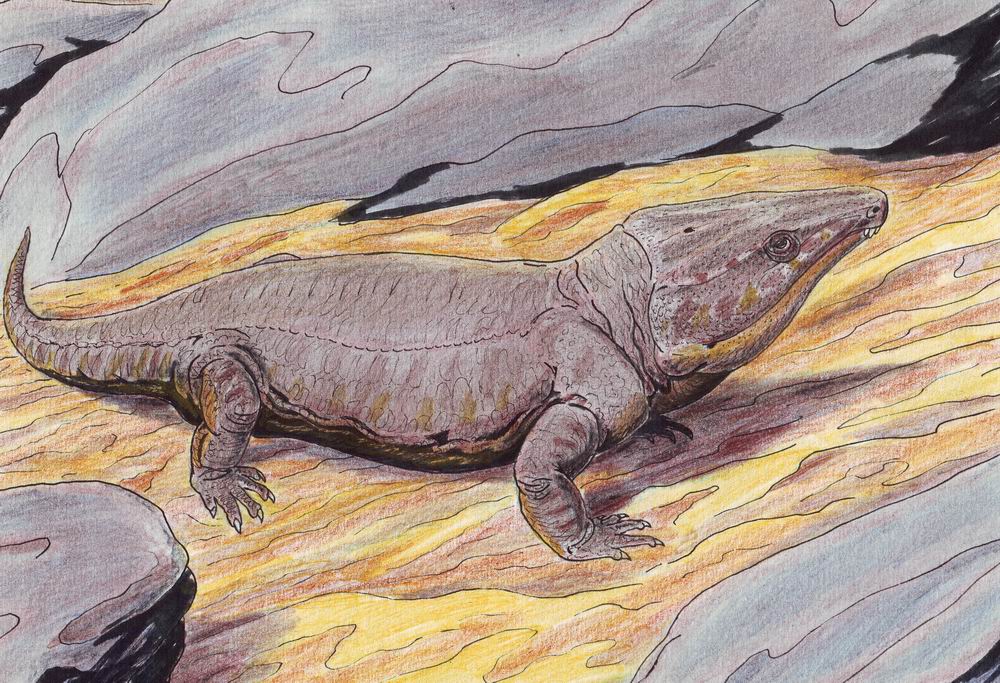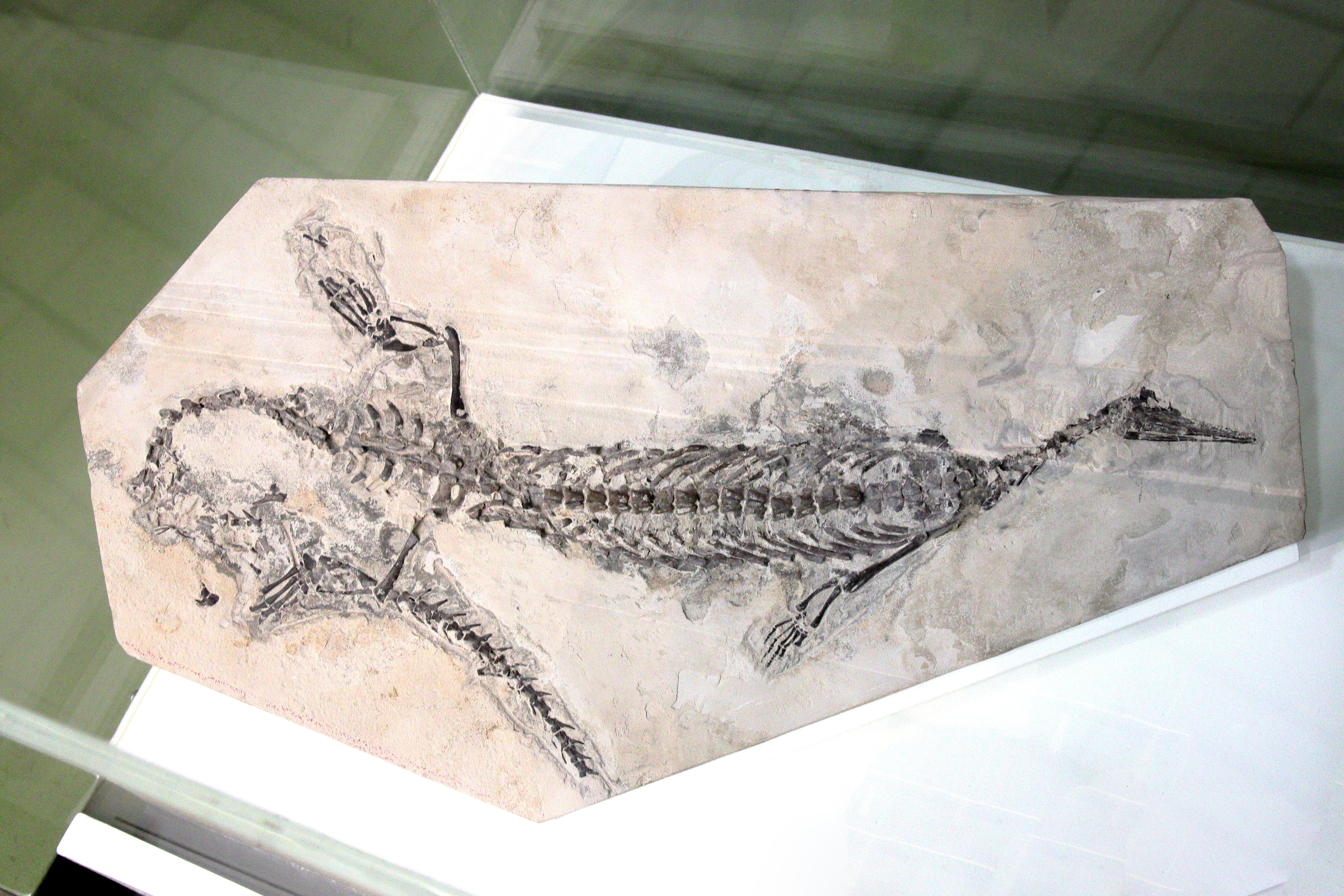|
Eureptilia
Sauropsida (Greek for "lizard faces") is a clade of amniotes, broadly equivalent to the class Reptilia, though typically used in a broader sense to also include extinct stem-group relatives of modern reptiles and birds (which, as theropod dinosaurs, are nested within reptiles as more closely related to crocodilians than to lizards or turtles).Gauthier J.A. (1994): ''The diversification of the amniotes''. In: D.R. Prothero and R.M. Schoch (ed.) Major Features of Vertebrate Evolution: 129–159. Knoxville, Tennessee: The Paleontological Society. The most popular definition states that Sauropsida is the sibling taxon to Synapsida, the other clade of amniotes which includes mammals as its only modern representatives. Although early synapsids have historically been referred to as "mammal-like reptiles", all synapsids are more closely related to mammals than to any modern reptile. Sauropsids, on the other hand, include all amniotes more closely related to modern reptiles than to mamma ... [...More Info...] [...Related Items...] OR: [Wikipedia] [Google] [Baidu] |
Parareptilia
Parareptilia ("near-reptiles") is an extinct group of basal sauropsids (" reptiles"), traditionally considered the sister taxon to Eureptilia (the group that likely contains all living reptiles and birds). Parareptiles first arose near the end of the Carboniferous period and achieved their highest diversity during the Permian period. Several ecological innovations were first accomplished by parareptiles among reptiles. These include the first reptiles to return to marine ecosystems (mesosaurs), the first bipedal reptiles ( bolosaurids such as '' Eudibamus''), the first reptiles with advanced hearing systems ( nycteroleterids and others), and the first large herbivorous reptiles (the pareiasaurs). The only parareptiles to survive into the Triassic period were the procolophonoids, a group of small generalists, omnivores, and herbivores. The largest family of procolophonoids, the procolophonids, rediversified in the Triassic, but subsequently declined and became extinct by t ... [...More Info...] [...Related Items...] OR: [Wikipedia] [Google] [Baidu] |
Parareptile
Parareptilia ("near-reptiles") is an extinct group of Basal (phylogenetics), basal Sauropsida, sauropsids ("Reptile, reptiles"), traditionally considered the sister taxon to Eureptilia (the group that likely contains all living reptiles and birds). Parareptiles first arose near the end of the Carboniferous, Carboniferous period and achieved their highest diversity during the Permian, Permian period. Several ecological innovations were first accomplished by parareptiles among reptiles. These include the first reptiles to return to marine ecosystems (mesosaurs), the first Bipedalism, bipedal reptiles (Bolosauridae, bolosaurids such as ''Eudibamus''), the first reptiles with advanced hearing systems (Nycteroleteridae, nycteroleterids and others), and the first large herbivorous reptiles (the pareiasaurs). The only parareptiles to survive into the Triassic, Triassic period were the Procolophonoidea, procolophonoids, a group of small generalists, omnivores, and herbivores. The largest f ... [...More Info...] [...Related Items...] OR: [Wikipedia] [Google] [Baidu] |
Captorhinid
Captorhinidae is an extinct family of tetrapods, traditionally considered primitive reptiles, known from the late Carboniferous to the Late Permian. They had a cosmopolitan distribution across Pangea. Description Captorhinids are a clade of small to very large lizard-like animals that date from the Late Carboniferous through the Permian. Their skulls were much stronger than those of their relatives, the protorothyridids, and had teeth that were better able to deal with tough plant material. The postcranial skeleton is similar to those of seymouriamorphs and diadectomorphs; these animals were grouped together with the captorhinids in the order Cotylosauria as the first reptiles in the early 20th century, but are now usually regarded as stem-amniotes no closer to reptiles than to mammals. Captorhinids have broad, robust skulls that are generally triangular in shape when seen in dorsal view. The premaxillae are characteristically downturned. The largest captorhinid, the ... [...More Info...] [...Related Items...] OR: [Wikipedia] [Google] [Baidu] |
Captorhinidae
Captorhinidae is an extinct family of tetrapods, traditionally considered primitive Reptile, reptiles, known from the late Carboniferous to the Late Permian. They had a cosmopolitan distribution across Pangea. Description Captorhinids are a clade of small to very large lizard-like animals that date from the Late Carboniferous through the Permian. Their skulls were much stronger than those of their relatives, the protorothyridids, and had teeth that were better able to deal with tough plant material. The postcranial skeleton is similar to those of seymouriamorphs and diadectomorphs; these animals were grouped together with the captorhinids in the order Cotylosauria as the first reptiles in the early 20th century, but are now usually regarded as Stem group, stem-amniotes no closer to reptiles than to mammals. Captorhinids have broad, robust skulls that are generally triangular in shape when seen in dorsal view. The premaxillae are characteristically downturned. The largest captorh ... [...More Info...] [...Related Items...] OR: [Wikipedia] [Google] [Baidu] |
Protorothyrididae
Protorothyrididae is an extinct family (biology), family of small, lizard-like reptiles belonging to Eureptilia. Their skulls did not have Fenestra (anatomy), fenestrae, like the more derived diapsids. Protorothyridids lived from the Late Carboniferous to Cisuralian, Early Permian periods, in what is now North America. Many genera of primitive reptiles were thought to be protorothyridids. ''Brouffia'', ''Coelostegus'', ''Paleothyris'' and ''Hylonomus'', for example, were found to be more basal (phylogenetics), basal eureptiles in Muller and Reisz (2006), making the family as historically defined paraphyletic, though three genera, ''Protorothyris, Anthracodromeus,'' and ''Cephalerpeton'', were recovered as a monophyletic group. ''Anthracodromeus'', ''Paleothyris'', and ''Protorothyris'' were recovered as a monophyletic group in Ford and Benson (2020) (who did not sample ''Cephalerpeton''), who recovered them as more derived than captorhinids and ''Hylonomus'', but less so than arae ... [...More Info...] [...Related Items...] OR: [Wikipedia] [Google] [Baidu] |
Thuringothyris
''Thuringothyris'' is an extinct genus of Early Permian eureptiles known from the Thuringian Forest in central Germany. Description ''Thuringothyris'' is known from the holotype MNG 7729, articulated well-preserved skull and partial postcranial skeleton, and from the referred specimens MNG 10652, poorly preserved skull and partial vertebral column, MNG 10647, disarticulated cranial and postcranial remains of at least four individuals, MNG 10183, slightly crushed skull and partial postcranial skeleton and MNG 11191, poorly preserved skull and partial limbs. All specimens were collected from the Tambach-Sandstein Member, the uppermost part of the Tambach Formation, dating to the Artinskian stage of the Late Cisuralian Series (or alternatively upper Rotliegend), about 284–279.5 million years ago. They were found in the Bromacker Quarry, the middle part of the Thuringian Forest, near the small town of Tambach-Dietharz. ''Thuringothyris'' was originally ... [...More Info...] [...Related Items...] OR: [Wikipedia] [Google] [Baidu] |
Mesosaur
Mesosaurs ("middle lizards") were a group of small aquatic reptiles that lived during the early Permian period ( Cisuralian), roughly 299 to 270 million years ago. Mesosaurs were the first known aquatic reptiles, having apparently returned to an aquatic lifestyle from more terrestrial ancestors. It is uncertain which and how many terrestrial traits these ancestors displayed; recent research cannot establish with confidence if the first amniotes were fully terrestrial, or only amphibious. Most authors consider mesosaurs to have been aquatic, although adult animals may have been amphibious, rather than completely aquatic, as indicated by their moderate skeletal adaptations to a semiaquatic lifestyle.Pablo Nuñez Demarco et al. Was Mesosaurus a Fully Aquatic Reptile? Front. Ecol. Evol, published online July 27, 2018; doi: 10.3389/fevo.2018.00109 Similarly, their affinities are uncertain; they may have been among the most basal sauropsids or among the most basal parareptiles (in ... [...More Info...] [...Related Items...] OR: [Wikipedia] [Google] [Baidu] |
Mesosauria
Mesosaurs ("middle lizards") were a group of small aquatic reptiles that lived during the early Permian period (Cisuralian), roughly Geologic time scale, 299 to 270 million years ago. Mesosaurs were the first known aquatic reptiles, having apparently returned to an aquatic lifestyle from more terrestrial ancestors. It is uncertain which and how many terrestrial traits these ancestors displayed; recent research cannot establish with confidence if the first amniotes were fully terrestrial, or only amphibious. Most authors consider mesosaurs to have been aquatic, although adult animals may have been amphibious, rather than completely aquatic, as indicated by their moderate skeletal adaptations to a semiaquatic lifestyle.Pablo Nuñez Demarco et al. Was Mesosaurus a Fully Aquatic Reptile? Front. Ecol. Evol, published online July 27, 2018; doi: 10.3389/fevo.2018.00109 Similarly, their affinities are uncertain; they may have been among the most basal sauropsids or among the most basal p ... [...More Info...] [...Related Items...] OR: [Wikipedia] [Google] [Baidu] |
Procolophonia
Procolophonia is an extinct suborder (clade) of herbivorous reptiles that lived from the Middle Permian till the end of the Triassic period. They were originally included as a suborder of the Cotylosauria (later renamed Captorhinida Carroll 1988) but are now considered a clade of Parareptilia. They are closely related to other generally lizard-like Permian reptiles such as the Millerettidae, Bolosauridae, Acleistorhinidae, and Lanthanosuchidae, all of which are included under the Anapsida or "Parareptiles" (as opposed to the Eureptilia). Classification There are two main groups of Procolophonia, the small, lizard-like Procolophonoidea, and the Pareiasauroidea, which include the large, armoured Pareiasauridae. According to the traditional classification of Carroll 1988 as well as phylogenetic analyses of 2012, smaller groups like Rhipaeosauridae (now a synonym of Nycteroleteridae) and Sclerosauridae are classified with the pareiasaurs and with the procolophonids, ... [...More Info...] [...Related Items...] OR: [Wikipedia] [Google] [Baidu] |
Labidosaurikos
''Labidosaurikos'' is a genus of extinct captorhinid tetrapods that lived around 279 to 272 million years ago during Kungurian age of the lower Permian. The American paleontologist John Willis Stovall first described ''Labidosaurikos'' in 1950, naming it "Labidosaurus like" for the striking similarity of the holotype skull of his specimen to the cranial anatomy of another captorhinid ''Labidosaurus hamatus''.Stovall, J.W., 1950. A new cotylosaur from north central Oklahoma. ''American Journal of Science'', 248(1), pp.46-54. ''Labidosaurikos'' is an important find in Red Beds of Texas and Oklahoma, Permian red beds of North America, where captorhinids are commonly found, as it is a key discovery in the evolution of herbivory in large captorhinids given its multi-row tooth plates.LeBlanc, A.R., Brar, A.K., May, W.J. and Reisz, R.R., 2015. Multiple tooth-rowed captorhinids from the Early Permian fissure fills of the Bally Mountain Locality of Oklahoma. ''Vertebrate Anatomy Morphology ... [...More Info...] [...Related Items...] OR: [Wikipedia] [Google] [Baidu] |
Microleter
''Microleter'' is an extinct genus of basal (phylogenetics), basal Procolophonomorpha, procolophonomorph parareptiles which lived in Oklahoma during the Early Permian period. The type species, type and only known species is ''Microleter mckinzieorum''. ''Microleter'' is one of several parareptile taxa described from the Richards Spur fissure fills, and can be characterized from its high tooth count, Lacrimal bone, lacrimal/Nostril, narial contact, short Postfrontal bone, postfrontal, and slit-like Infratemporal fenestra, temporal emargination edged by the Postorbital bone, postorbital, Jugal bone, jugal, Squamosal bone, squamosal, and Quadratojugal bone, quadratojugal. Contrary to ''Australothyris'', which had a similar Phylogenetics, phylogenetic position as a basal procolophonomorph, ''Microleter'' suggests that early parareptile evolution occurred in Laurasia and that multiple lineages developed openings or emarginations in the temporal region. Discovery The only known specim ... [...More Info...] [...Related Items...] OR: [Wikipedia] [Google] [Baidu] |
Erpetonyx
''Erpetonyx'' is an extinct genus of bolosaurian parareptile from the Gzhelian stage of the Carboniferous period, with a single known species: ''Erpetonyx arsenaultorum''. It is known from a single articulated and mostly complete specimen from Prince Edward Island in Canada. Phylogenetics has predicted that parareptiles first evolved in the Carboniferous, parallel to Eureptilia, eureptiles ("true reptiles"). However, ''Hylonomus'', the oldest eureptile known from fossil evidence, lived millions of years before parareptiles appeared in the fossil record. The discovery of ''Erpetonyx'' helped to shorten this gap between parareptile and eureptile fossils, as ''Erpetonyx'' lived in the Late Carboniferous and is one of the oldest known parareptiles (though ''Carbonodraco'' is now known to be older). However, it was not closely related to ancestral parareptiles, so its discovery also indicated that the initial diversification of parareptiles occurred earlier in the Carboniferous. ''Erpe ... [...More Info...] [...Related Items...] OR: [Wikipedia] [Google] [Baidu] |






